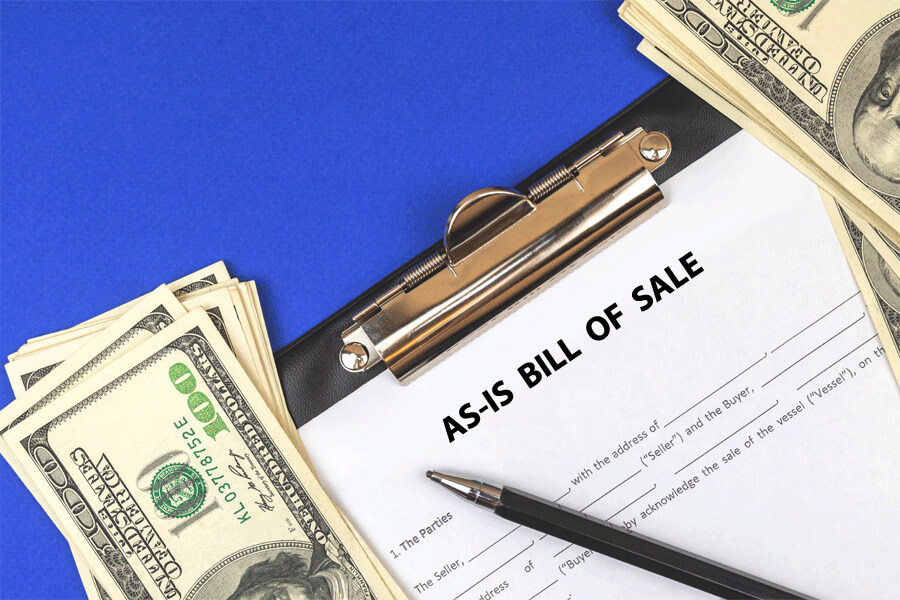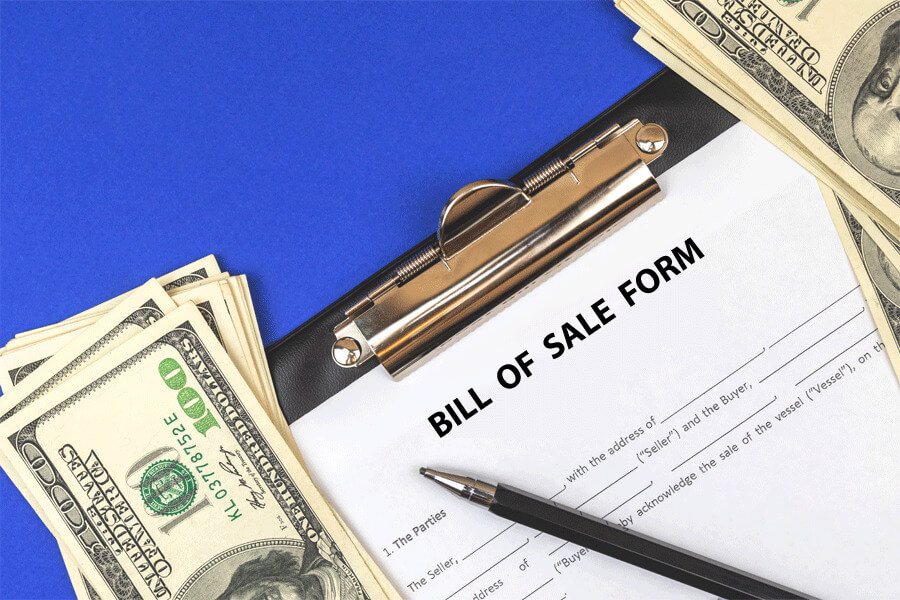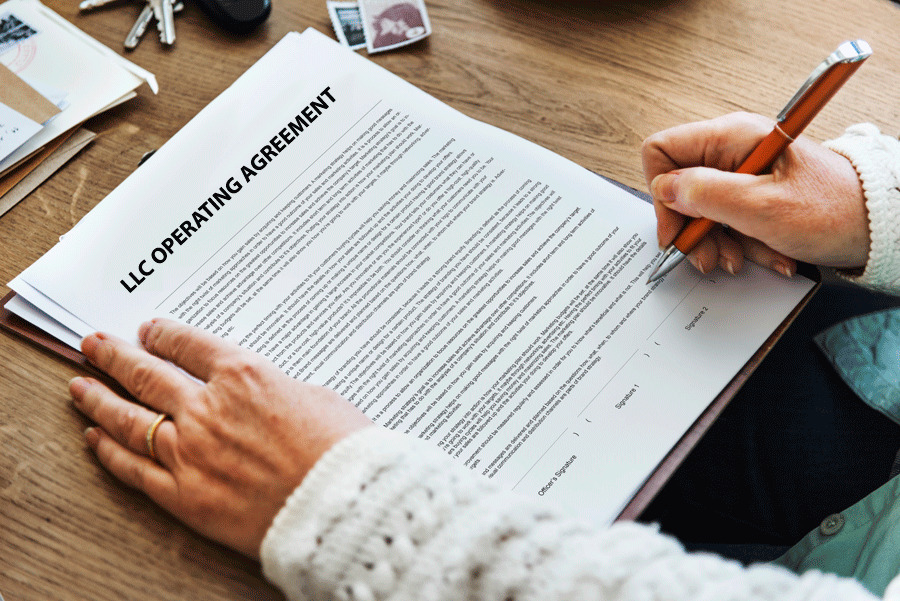An As-Is Bill of Sale, also known as the No Warranty Bill of Sale, is a form that a seller uses to document the purchase of an item in its current condition.
The term “As-Is” means that the buyer has agreed to purchase the item with all its faults (visible or hidden), and the seller does not guarantee the quality of the product to the buyer. Once the transaction is finalised, and both parties sign the bill of sale form, all ownership rights, including the property’s title, are transferred to the buyer, and the seller relinquishes liability for the sold item.
An as-is bill of sale serves as a receipt as it proves that full consideration has been made in a transaction and that the seller has transferred property ownership rights to the new owner detailed in the form. As a seller, an as-is bill of sale is preferable in cases where you are selling any used item, for example, a used vehicle, equipment, motorcycles, bicycle, campers, boats, furniture, or any other used personal property.
The no warranty bill of sale form shelters you from liability should the sold item be found faulty or have unforeseen problems, as it does not make any promises about the item’s performance or guarantee the item has no claims against it. This safeguards your transaction as it protects you from providing a refund for any item-related issues once the buyer pays for and receives the item.
What is a Bill of Sale
It is a legally binding document outlining the terms of a given sale and confirming that a specific item was sold to a given buyer. The document usually includes the seller and buyer’s identifying information, conditions attached to the sale, the date the transfer is made, the agreed-upon purchase price, and both party’s signatures.
A form for bill of sale becomes necessary when a seller wants to sell any personal property, for example, automobiles, bicycles, motorcycles, watercraft, pets and animals, furniture, a laptop, jewellery, etc.
Free Templates
Following are some free downloadable templates for you:
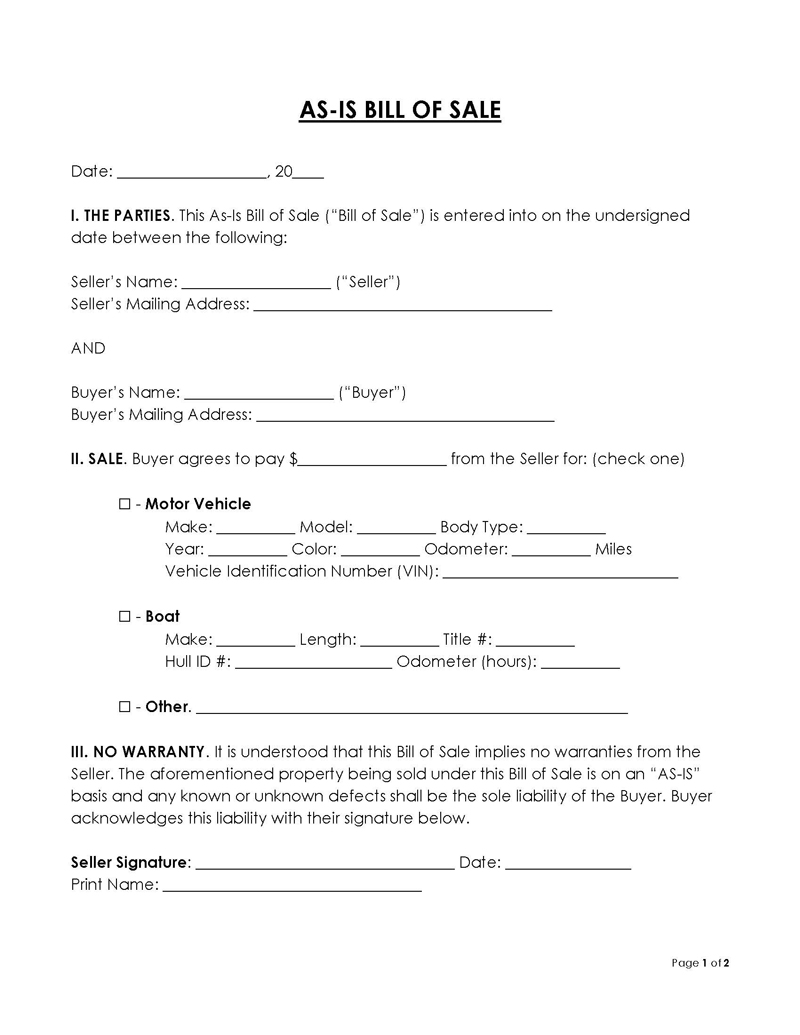
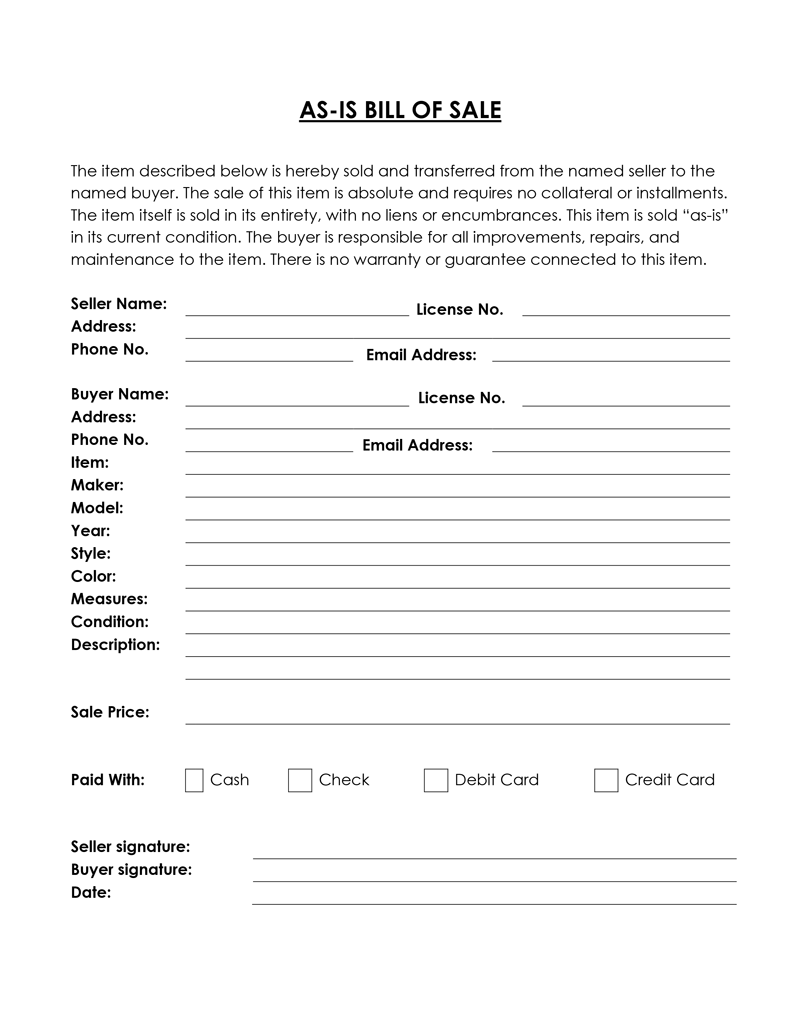
As-Is Bill of Sale Vs. Sales Contract
When a purchaser and seller engage in the sale of any valuable item, paperwork documenting the sale becomes necessary to legalise the transaction. The required paperwork may include a sales contract and a bill of sale. Both documents serve a different purpose in completing the transaction, and they are executed at different times. Here are the main differences between a sales contract and an as-is bill of sale:
A sales contract is a legally binding agreement between a seller and a buyer. The seller contracts to provide something at a given monetary value, and the buyer agrees to purchase the goods at the agreed-upon price. The exchange might occur immediately or in the future- where the buyer agrees to make regular monthly payments/instalments before taking full ownership of the goods, but the important point to remember is that the sales agreement is used before any goods are exchanged.
On the other hand, a bill of sale is used during or after the transaction has been finalized to ensure that the property’s title is transferred to the new owner. In most cases, the form for the bill of sale is executed when money changes hands.
The primary purpose of a sales contract is to ensure that both the seller and the buyer form an agreement concerning how the exchange of goods will take place. It outlines the relevant terms and conditions of the sale, including the payment method, the date of the transfer, warranties, and any other special conditions.
On the other hand, the bill of sale’s primary purpose is to finalise the sale by handing over all ownership rights to the buyer. The bill outlines all the details pertaining to the transaction as a way to protect both parties if a disagreement about the condition of the item or terms of the sale occurs.
It may also include warranties and other special conditions such as “as-is” sale and may need to be witnessed or notarized, or both, in some states.
Types of a Bill of Sale
There are two main types of a bill of sale: the absolute bill of sale used in the sale of valuable items as governed by the common law and the conditional bill that is usually used for borrowing and financing.
Absolute bill of sale
A bill of sale is termed absolute when the property transfer is made in full without any payments due after the transaction is completed or restrictions placed on the buyer. Absolute bills of sale typically detail the form of payment used and the condition of the property.
They are ideal for transactions that involve full cash payment and items sold in “as-is” conditions such as a used vehicle or equipment. Once the transaction is complete, the buyer gets full ownership rights and title of the item, and the seller can make no further monetary demands.
Conditional bill of sale
A conditional bill of sale conveys property with conditions and restrictions on the buyer’s ownership. With this bill of sale, ownership of the given property depends on meeting certain conditions, such as making regular payments or honouring specific terms of the purchase agreement, failure to which the seller may repossess the item.
A conditional bill of sale creates security in favour of the grantee of the bill as they are given the personal right of seizure. Therefore it is ideal for transactions involving loans, such as the purchase of a house using a mortgage. They are also appropriate for sellers that wish to place specific requirements on buyers, such as pet breeders.
How to Make an As-Is Bill of Sale Template
A bill of sale template is an editable and printable form that you can access online, download, personalised to suit your preferences, and use to record the transfer or sale of an item.This template is convenient to use as it is easier to complete and is often professionally formatted, ensuring that you include all the essential components of an effective bill of sale.
However, before selecting a suitable template to record your as-is sale, remember to check your individual state requirements regarding as-is bill of sale forms and make sure to conform to your relevant state statutes.
The following is a step-by-step guide on how to complete an as-is bill of sale template:
Add the date of reference for the sale
First, you will need to provide the exact date of the sale and when the transfer of ownership of the given item would be effective. The appropriate way to date your bill of sale is by following the month/calendar day/year format. The main reason for including the sale’s actual date is an easier reference in case of future disagreements between the seller and buyer regarding the sold item or terms of the sale.
Include the seller’s details
An as-is bill of sale must include the seller’s identifying information, including their official name and current and valid mailing address. Including the seller’s identifying details is essential as it proves that the person selling the item has a valid title and the right to transfer the title. This helps in reassuring the purchaser and also prevents the possibility of fraudulent sales.
Include purchaser’s details
A well-formulated as-is bill of sale should also contain information relating to the buyer of the item. This includes the purchaser’s name and their valid and correct contact information, including their mailing addresses.
Providing the purchaser’s accurate identifying information ensures that the seller gets paid for the sold item. It also provides legal evidence that the seller transferred their ownership rights to the purchaser described in the form.
Thus, if the buyer is questioned about ownership of the given item, or any disputes between the buyer and the seller comes up in the future, the document can be referenced as legal evidence in a court of law.
Enter the as-is transaction amount
The as-is transaction amount or agreed-on purchase price is another essential component of an as-is bill of sale that must be detailed in the template. Record the exact amount of money the buyer has agreed to pay the seller in exchange for the item in words and numerals. In addition, specify the mode of payment used, such as cash payment, using a check or credit card, and include any agreed-upon payment plan, if applicable.
Describe the purchase details
After providing the as-is transaction amount or the purchase price, you will need to provide a detailed description of the item being sold. This includes the item’s identifying features such as the type, make, model, color, breed, year, among other identifying features.
If the item is a vehicle, you will also need to disclose additional information such as the odometer reading, vehicle identification number (VIN), and license plate number. Since the sale is as-is, you will need to include an as-is clause disclosing that the buyer has agreed to buy the item in its current state with all its defects, visible or not.
The as-is clause will also contain language indicating that the seller provides no guarantees concerning the quality and performance of the item to the buyer, thus will not be liable for any flaws or imperfections in the item after the sale is completed.
Verify the sale under no warranty conditions
Both parties will need to read, understand, and agree to the transaction terms, including the as-is transaction amount, the condition of the sale, and finally verify the sale under no warranty conditions by signing the document.
For the seller, the no warranty conditions imply that they have agreed to transfer ownership rights to the stated as-is property in exchange for the specified dollar amount, meaning that they cannot request any additional amount from the buyer after that fact.
From the buyer’s perspective, verification of the sale under no warranty conditions means they have agreed to pay for the item under its current state. Thereafter, if the purchased item becomes faulty or suddenly stops functioning, the buyer will bear all their losses.
Signature
The final step of completing an as-is bill of sale involves signing the document. Both parties will have to sign the document to finalise the transaction and make the agreement legally binding. The buyer must sign their name on the buyer’s signature line, write the date of signing the form and provide their printed name.
The seller will also need to sign their name on the seller’s signature line, provide the date and their printed name. Depending on the specific state upon which the transaction is made, the presence of a witness at the time of signing may be required, and it may need to be notarized to be valid.
Once both parties sign the document, full payment should be made for the sold item and the transfer of the item made to its new owner. At this stage, the transaction is considered complete and the agreement legally binding. The original copy of the as-is bill of sale form should be issued to the buyer for proof of purchase, and the seller can make copies of the document and retain them for their reference and record keeping.
Final Words
An as-is bill of sale is an important document that outlines the terms of the sale and serves as legal proof that an item was sold in its current condition. When writing an as-is bill of sale, you should include the buyer and seller’s identifying information, conditions attached to the transfer, the date of the sale, the agreed-upon as-is purchase price, a detailed description of the item being sold, no warranty disclosure, and signatures of both the buyer and the seller.







